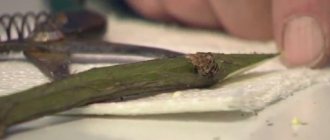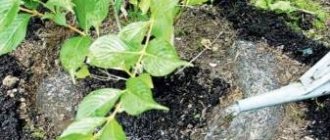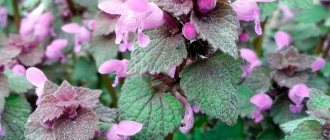Tree peonies amaze gardeners with their beauty and delightful aroma. To effectively plant them in a flowerbed, the owner should choose the right variety, study the intricacies of planting peonies from seeds, the peculiarities of dividing bushes, the rules of propagation by cuttings, layering and grafting.
Tree peony is a deciduous shrub that grows to a height of up to two meters. It has straight massive stems of light brown color, which, unlike most other flowers, do not die off in the fall, but grow and thicken every year, forming a hemispherical bush. The tree peony has beautiful openwork leaves and large (12 - 20 cm in diameter) flowers. Depending on the variety, the buds may have different shapes and colors. All this, coupled with excellent cold resistance, makes the tree peony an excellent garden plant for Russia, and therefore domestic gardeners should know how to plant a tree peony correctly.
Varieties of tree peonies
All modern varieties of tree peonies are based on several natural species:
- peony Lemoine,
- yellow peony,
- Delaway peony,
- Potanin's peony.
At the same time, these flowers are most actively cultivated in China. Accordingly, all varieties are divided into three main groups:
- Chinese-European peonies. These varieties are characterized by massive, heavy flowers that droop towards the ground under their own weight.
- Japanese varieties. They have relatively small, light buds that seem to float above the bush.
- Hybrids of Delaway peony and yellow peony. The most popular group of varieties, distinguished by yellow flowers.
The variety of shades of petals allows gardeners to decide at their own discretion which flowers to plant next to peonies. Among domestic flower growers today, the most common tree peonies are the following varieties:
- Kiao sisters. They are loved for their massive (up to 16 cm) two-color inflorescences - half of the bud is dark red, half is white and cream.
- Sapphire. The flowers are up to 18 cm in diameter and have a pale pink color with a dark crimson center.
- Coral altar. Another bicolor variety. The crown-shaped flowers combine salmon and white shades. The diameter of the inflorescences is up to 20 cm.
- Green Jade. Graceful light green buds.
Types of peonies by ripening time
The flowering time is affected by the variety of ornamental perennial, the climate in which it grows, and care features.
Very early
In American hybrids, surprising with double buds or a magnificent crown of petals, the decorative period begins at the end of May. The Velma variety has reddish stems and large lilac caps.
Early
In the first ten days of June, the Pearl Placer blooms. The peony sends out many shoots, growing up to 80 cm in height. The pearlescent shade of the petals at the ends turns into a dark pink color.
At the same time, the hybrid variety America pleases with scarlet flowers with golden stamens.
Mid-early
Until June 15, the buds of the Mirage peony bloom. Raspberry petals change shade in different lighting and smell like jasmine.
The Duchess variety, created by French breeders many years ago, continues to amaze with its airy snow-white flowers about 20 cm in diameter.
The Miss America peony bush is spherical in shape. The plant tolerates frost well, blooms buds in early June, large pure white flowers with yellow stamens look like chamomile.
Average
Light pink petals with an edge of the double peony in Memory of Gagarin open in the middle of the first summer month. Then the dark burgundy buds of the Sable variety appear.
Mid-late
After June 25, double spherical Anchatress peonies bloom, collected from lemon petals, decorated with a thin scarlet border. At the end of the month, the John Peyton variety blooms lilac buds.
Late
In the thirties of June, the spreading peony Arkady Gaidar with leaves decorated with scarlet veins blooms. Gladys Taylor pleases with dark pink terry balls.
Very late
In July, the snow-white flowers of the Swan variety open, the fragrant Adonis with golden reflections on the petals is fragrant, Moon River amazes with its delicate terry caps, decorated with blush.
Planting tree peonies
Most amateur gardeners plant tree peonies as seedlings. This procedure is carried out only in early autumn: the second half of August - the end of September. We will tell you how to properly plant a tree peony in the spring a little later.
Choosing the right planting site is one of the most important steps in this process. Tree peonies are very capricious when it comes to sunlight. They absolutely do not like shade, so be sure to make sure that no tree or building blocks the sun in the place where the peonies will be planted. It is better from the very beginning to give preference to areas located at a certain elevation, where there is always enough sunlight.
Tree peonies prefer loamy soils, which is why it is recommended to dilute sandy soils with clay, humus, peat and turf soil. On the contrary, excessively clayey soil should be refined with sand and organic fertilizers. You should not neglect the issues of preparing a site for planting peonies, since the life expectancy of plants largely depends on the quality of the soil.
If the groundwater level is low, the hole for planting seedlings should be made in the form of a cone. Its dimensions should be 70 cm in diameter at the surface and 70 cm in total depth. Gravel, broken brick, or sand should be laid at the bottom of the cone in a layer of about 20-30 cm. If planting is carried out in acidic soil, 200-300 g of lime or bone meal should be added to the hole, and only then can you begin to fill the soil. When planting, it is recommended to water the roots of the plant abundantly so that they straighten. The hole can be completely filled with soil only after the water has been completely absorbed into the soil. It is very important that the root collar ends up exactly at surface level. Tree peonies do not tolerate very well when they are planted too deep or, conversely, too high. If you have several seedlings, place them at a distance of at least one and a half meters from each other.
Why do peonies bloom poorly?
Most often this happens because the place for planting them is chosen incorrectly (low, with close groundwater, shaded).
Dry soil in the autumn of the previous year has an unfavorable effect on flowering. Plants in such conditions do not store enough nutrients to bloom next year and the year after.
Another very common reason is buried or, conversely, too shallow, as well as very late planting.
If peonies have not been dug up or divided for many years, their rhizomes grow, rise above ground level, and the buds become smaller. This also results in poor flowering.
The flowering of peonies is worsened by the development of diseases: gray rot, late blight, leaf spot.
Growing tree peony from seeds
Now let's look at how to properly plant tree peony seeds. Typically, professional flower growers are involved in breeding tree peonies from seeds, since this method is much more complicated. In addition, the plant will need 5-6 years for the seed to turn into a flowering bush, while seedlings, depending on their age, can bloom in the first or second year.
In addition, for tree peony seeds to germinate, they require mandatory stratification. In addition, with more or less long-term storage, the seeds completely lose their viability. Thus, growing tree peonies by sowing requires much more patience with no guaranteed results.
The fruits of this plant ripen in September - early October. You can tell that the seeds are ready for collection by looking at the slightly open seed pod. The most viable seeds are large (up to a centimeter in length) seeds that have a shiny, smooth, dark-colored surface. Sowing is carried out after three days of drying. Seeds are placed to a depth of 3 cm in loose, fertile soil until the first frost. It is better if the soil is moist. On the eve of winter, it is recommended to cover the sowing site.
Theoretically, some of the seeds can sprout in the spring, but in most cases, tree peony germinates only in the second or even third year. It is in order to guarantee high germination already in the first spring that it is recommended to subject the seeds to temperature stratification. For this purpose, in the fall, the seeds are buried not in open ground, but in a pot or box with soil. After the pot/box of seeds has overwintered outside, it should be taken indoors in March and kept at room temperature. By following these steps, you can guarantee a fairly high germination rate even in the first spring.
An alternative way to increase the germination of seeds is to collect them immature and place them in damp sand or peat for 10-12 weeks at room temperature. After this, the seeds should be placed in the refrigerator or basement so that they remain at a temperature of 5-8 degrees for about 3 months. In May, such seeds can be planted in open ground at a depth of up to 5 cm. The seedlings should hatch before autumn and will grow very slowly. They should be watered very sparingly, and 3-4 weeks after planting they can be fed with liquid fertilizers. The soil around the shoots is mulched, and for the winter the plants need to be thoroughly covered with peat or dry leaves. You can learn more about how to properly plant a tree peony in the spring from a special video.
Short description
Paeonia suffruticosa is a perennial deciduous plant with erect shoots and a woody trunk. It can grow up to 1.5-2.0 m. The roots are cone-shaped, reach 1 cm in diameter, and grow superficially.
Leaves are medium sized, green. Characteristic openwork, distributed symmetrically.
The flowers are large, located at the ends of the shoots. They can be single, double or semi-double. The buds bloom in May - June, flowering lasts up to 3 weeks and can increase significantly as the plant ages. There is a strong aroma.
The most common petal colors are:
- white;
- two-color;
- yellow;
- crimson;
- pink;
- violet.
After flowering, fruits are set on the stems in the form of a pointed capsule with black seeds 0.4-1.0 cm.
The main feature of varieties with fancy or double flower shapes is considered to be gradual compliance with the botanical characteristics of the species in the 2-3rd year of life after planting. Usually all young seedlings have simple ones.
Propagation of tree peonies
Like most other garden flowers, tree peonies can be propagated either by seeds or seedlings. We have already talked about how this is done. Now let's look at the main ways to get planting material.
Seeds and ready-made seedlings can be bought on the market or in a specialized nursery. This method is so simple that there is no point in describing it in detail. It is much more interesting to consider ways to independently obtain new plants. If you have at least minimal experience in floriculture and gardening, you can propagate peonies:
- dividing the bush,
- cuttings
- layering,
- vaccination.
How to plant store-bought peonies in spring
What to do with a seedling bought in a box in the spring? There is no point in waiting for autumn, because peonies take root even when planted in spring. At the beginning of the growing season, the soil temperature is still low, so the plant will have time to grow roots before the buds revive. The success of cultivation primarily depends on the purchase of high-quality planting material. When choosing, the information on the packaging is evaluated. A bona fide manufacturer must indicate:
- peony variety;
- number and age of divisions;
- description of the plant;
- landing instructions.
Reproduction of peonies by dividing the bush
This procedure involves transplanting part of a bush to a new location. Even a whole bush does not tolerate moving to a new place very well, and even more so a halved plant. You should resort to this technique only as a last resort, for example, if you still plan to dig up an old bush and do not value it very much.
To divide the bush, simply stretch its parts to the sides near the root collar. In this case, “surgical” intervention may be required. Make sure that the newly formed bush has sufficient buds and roots. Before planting in a new location, immerse the plant in a clay mash for 20-30 minutes.
For propagation by division, it is best to take bushes that are 5-6 years old. Separation is recommended to be carried out in August.
By the way, a few words about what flowers can be planted next to peonies: after transplantation, peonies feel very bad. It may take them several years to fully recover. In view of this, you should not plant other massive flowers nearby, which will suck water and nutrients from the common flower bed, and also create shadow.
Difference Between Species
The main differences between peonies:
| No. | tree-like | Grassy |
| 1 | Height 1.5-2.0 m. | Reaches 1.0 m. |
| 2 | Shrub with a hard woody trunk. | Herbaceous soft shoots. |
| 3 | The first buds are not removed. | Cut to stimulate growth. |
| 4 | The flowers are large – up to 30 cm. | Up to 20 cm. |
| 5 | Large species diversity - there are over 1000 varieties. | Up to 500 titles. |
Common features are the presence of hybrid varieties, which include the characteristics of two species at once, and the frost resistance of plants.
Reproduction by cuttings and layering
For cuttings, choose semi-woody shoots. It is better to cut them out from the second half of June. The finished cuttings should be stuck into the sand-peat mixture to a depth of 1.5 cm and covered with glass or film to create a greenhouse effect. Cuttings need to be watered and sprayed regularly. In the second half of September, rooted shoots are planted in individual pots and stored until spring in greenhouse conditions. Next year, young shoots can be planted in open ground.
The layering method is longer and takes two years. In May, before the bushes begin to bloom, you should select the most developed shoots and carefully bend them to the ground. In this case, on the side facing the soil, a small incision is made on the shoots, which should be treated with growth substance. The resulting cutting must be buried with a 10-centimeter layer of soil, and subsequently the soil above the cutting should be regularly moistened. By September, roots should appear on the branch; such a shoot can already be separated from the bush and planted in open ground in a permanent place.
Selection of seedlings
How to propagate a tree flower? Peonies are propagated by dividing the root system or by layering. Propagation by cuttings is also possible, but only rooted seedlings are sold in stores. You can root a cutting at home if you have at least one parent plant.
The purchased planting material can be of two types. With open or closed rhizome. A seedling with an open rhizome is placed in a package, while its root system is outside the ground. If the roots of the seedling are in the ground, it is a planting material with a closed rhizome. Such specimens may have a developing aerial part.
Purchased seedlings may have different root systems. If the plant is grafted, then its roots will be powerful and black, but if the planting material was obtained by layering, it will have thin light roots. The difference between these seedlings is that the first one will bloom the next year, and the second one a few years after planting. A more detailed description of the flowering period is usually indicated on the packaging.
Note! When purchasing planting material with thin roots, you need to pay attention to the number of buds, there should be at least 5 of them, and the length of the seedling itself should not be less than 25 cm. Growing short seedlings will not be successful.
Reproduction of tree peonies by grafting
Grafting is the most reliable and popular method of industrial propagation of tree peonies. For the same reason, it is recommended to use it in a private garden.
The grafting should be done on the roots of the herbaceous peony: in early August, cuttings with two buds are cut from tree peony bushes; The lower part of the cutting is ground to form a wedge and tightly inserted into a wedge-shaped groove previously made in the roots of the herbaceous peony. The junction is tightly wrapped in film and, in this form, the grafted peonies are placed in a box filled with wet sawdust.
The box is stored in a dark place for a month, and then the rooted cuttings are planted in a container or bed in a greenhouse filled with fertile soil. The grafted peony grows and strengthens in greenhouse conditions for the next one and a half to two years. Only then can it be planted in open ground
Pests and diseases
Tree peonies are not painful. Old and weakened bushes by replanting or weather conditions can be affected by gray rot, brown spot or powdery mildew. Having noticed signs of rotting, it is necessary to spray the bush with copper sulfate, potassium permanganate or other fungicide. Rotting stems should be burned. Areas affected by brown spot are removed, and the bush is treated with Bordeaux mixture. The plant is saved from powdery mildew with colloidal sulfur.
The main pests of tree peonies: aphids, ants, thrips, bronze beetles, root-knot nematodes, and mites. Modern fungicides successfully save them from them.
When to prune peonies, leaves of peonies after flowering, for the winter: pruning time
Many gardeners do not properly care for flowers and tend to cut them off immediately after the buds bloom. This is not entirely correct. It is necessary to wait until the petals on the bush dry completely and only then prune. You should not cut the bushes at the root; cut the bud itself to the first leaf. After this, the bush is left in this untouched form almost until frost.
When the stems go down and almost completely lie on the ground, only then is pruning done at the root. This is due to the fact that immediately after flowering, before the onset of the first cold weather, circulation of useful substances occurs along the stems and in the bushes. This has a positive effect on the formation of new buds, as well as on the development of the root system. Therefore, do not rush to prune after flowering. It is completely cut only after all the stems touch the ground.
Peony pruning
Peonies - care in autumn: what to do?
Bushes require care in the fall. Most often it comes down to fertilizing and pruning plants. Pruning is carried out in mid-October, because if this is not done, then in the spring the shoots will become soft and bend throughout the winter. They will be much more difficult to cut with pruning shears. Therefore, pruning is carried out almost at the root in the fall.
Instructions:
- It is necessary to choose a dry day to carry out the manipulation. If the weather has been dry outside for several days before, you need to pour a bucket of water under the bush and let it soak completely. Only after this is pruning done.
- All branches and leaves are removed from the site and burned. Under no circumstances should waste be left under the bush itself. This will contribute to the development of fungal diseases and various infections. All remains are removed from the site and burned.
- After this, fertilization with organic components is carried out. It is best to fertilize with mullein.
Peonies in autumn
How to prepare peonies for winter, do they need to be covered for the winter?
Preparation for winter is carried out immediately after flowering. It is necessary to perform a number of manipulations:
- Cut flowers
- Cut off all stems and harvest them
- Water the plants with fertilizers
- Take care of covering material
Tree peonies can freeze in winter. Typically a layer of straw is laid and the soil is mulched. After this, it is necessary to cover the bushes with agrofibre or oilcloth, which is secured with bricks or wooden boxes. You should not leave bushes uncovered. Since part of the root system may freeze during severe cold weather. Under no circumstances should fallen leaves be used as covering material. Because pathogens of dangerous diseases can persist in them.
Preparing for winter











